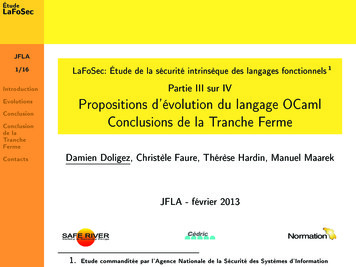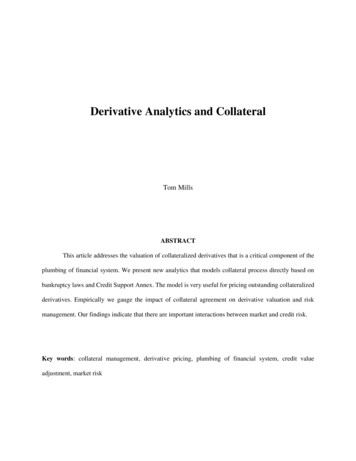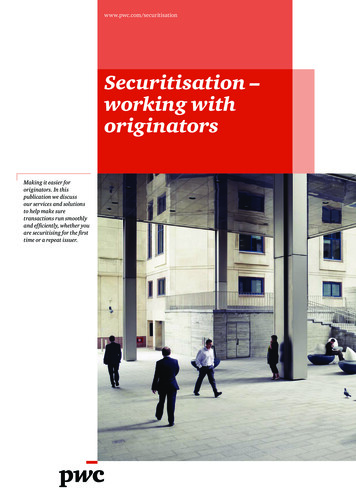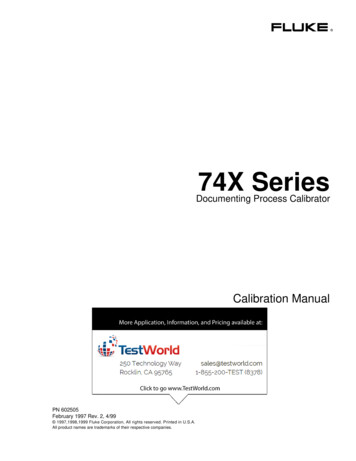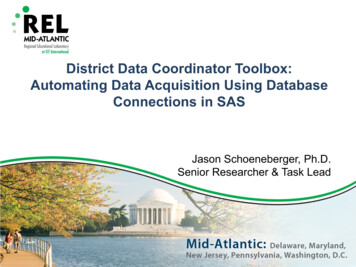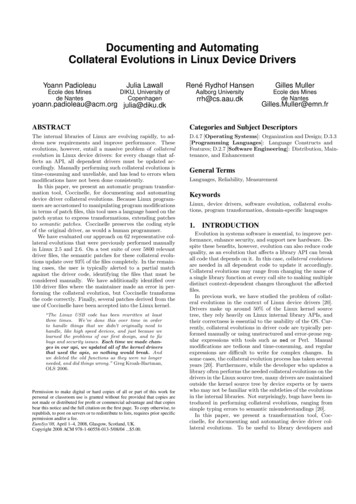
Transcription
Documenting and AutomatingCollateral Evolutions in Linux Device DriversYoann PadioleauJulia LawallRené Rydhof HansenGilles MullerEcole des Minesde NantesDIKU, University ofCopenhagenAalborg UniversityEcole des Minesde Nantesrrh@cs.aau.dkyoann.padioleau@acm.org s and Subject DescriptorsThe internal libraries of Linux are evolving rapidly, to address new requirements and improve performance. Theseevolutions, however, entail a massive problem of collateralevolution in Linux device drivers: for every change that affects an API, all dependent drivers must be updated accordingly. Manually performing such collateral evolutions istime-consuming and unreliable, and has lead to errors whenmodifications have not been done consistently.In this paper, we present an automatic program transformation tool, Coccinelle, for documenting and automatingdevice driver collateral evolutions. Because Linux programmers are accustomed to manipulating program modificationsin terms of patch files, this tool uses a language based on thepatch syntax to express transformations, extending patchesto semantic patches. Coccinelle preserves the coding styleof the original driver, as would a human programmer.We have evaluated our approach on 62 representative collateral evolutions that were previously performed manuallyin Linux 2.5 and 2.6. On a test suite of over 5800 relevantdriver files, the semantic patches for these collateral evolutions update over 93% of the files completely. In the remaining cases, the user is typically alerted to a partial matchagainst the driver code, identifying the files that must beconsidered manually. We have additionally identified over150 driver files where the maintainer made an error in performing the collateral evolution, but Coccinelle transformsthe code correctly. Finally, several patches derived from theuse of Coccinelle have been accepted into the Linux kernel.D.4.7 [Operating Systems]: Organization and Design; D.3.3[Programming Languages]: Language Constructs andFeatures; D.2.7 [Software Engineering]: Distribution, Maintenance, and Enhancement“The Linux USB code has been rewritten at leastthree times. We’ve done this over time in orderto handle things that we didn’t originally need tohandle, like high speed devices, and just because welearned the problems of our first design, and to fixbugs and security issues. Each time we made changes in our api, we updated all of the kernel driversthat used the apis, so nothing would break. Andwe deleted the old functions as they were no longerneeded, and did things wrong.” Greg Kroah-Hartman,OLS 2006.Permission to make digital or hard copies of all or part of this work forpersonal or classroom use is granted without fee provided that copies arenot made or distributed for profit or commercial advantage and that copiesbear this notice and the full citation on the first page. To copy otherwise, torepublish, to post on servers or to redistribute to lists, requires prior specificpermission and/or a fee.EuroSys’08, April 1–4, 2008, Glasgow, Scotland, UK.Copyright 2008 ACM 978-1-60558-013-5/08/04 . 5.00.General TermsLanguages, Reliability, MeasurementKeywordsLinux, device drivers, software evolution, collateral evolutions, program transformation, domain-specific languages1.INTRODUCTIONEvolution in systems software is essential, to improve performance, enhance security, and support new hardware. Despite these benefits, however, evolution can also reduce codequality, as an evolution that affects a library API can breakall code that depends on it. In this case, collateral evolutionsare needed in all dependent code to update it accordingly.Collateral evolutions may range from changing the name ofa single library function at every call site to making multipledistinct context-dependent changes throughout the affectedfiles.In previous work, we have studied the problem of collateral evolutions in the context of Linux device drivers [20].Drivers make up around 50% of the Linux kernel sourcetree, they rely heavily on Linux internal library APIs, andtheir correctness is essential to the usability of the OS. Currently, collateral evolutions in driver code are typically performed manually or using unstructured and error-prone regular expressions with tools such as sed or Perl. Manualmodifications are tedious and time-consuming, and regularexpressions are difficult to write for complex changes. Insome cases, the collateral evolution process has taken severalyears [20]. Furthermore, while the developer who updates alibrary often performs the needed collateral evolutions on thedrivers in the Linux source tree, many drivers are maintainedoutside the kernel source tree by device experts or by userswho may not be familiar with the subtleties of the evolutionsin the internal libraries. Not surprisingly, bugs have been introduced in performing collateral evolutions, ranging fromsimple typing errors to semantic misunderstandings [20].In this paper, we present a transformation tool, Coccinelle, for documenting and automating device driver collateral evolutions. To be useful to library developers and
A notion of isomorphisms, which equate semanticallyequivalent code fragments, to abstract away from variations in coding style, and the use of temporal logic toabstract away from variations in device-specific execution paths. The resulting genericity implies that, asshown in Section 5, a single semantic patch of under50 lines can suffice to update over 500 files.driver maintainers, this tool must meet the following challenges:Ease of use. Library developers and driver maintainers areoften not familiar with program transformation tools. Togain acceptance, a program transformation tool must thusfit with the notations and processes familiar to those workingon Linux code. Strategies to optimize the transformation process suchthat the average treatment time per affected driver is0.7 seconds and the entire Linux kernel can be processed in less than 1 minute.Preservation of coding style. Because a collateral evolution is just one step in the ongoing maintenance of a driver,transformed driver code must follow the same coding styleas the original. This includes preserving the use of macrosand C preprocessor directives, which are notoriously difficultto handle [7, 16]. An evaluation of Coccinelle on a range of over 60 typical collateral evolutions performed in earlier versionsof Linux. On this test suite, Coccinelle correctly updates over 93% of the files previously identified by thehuman programmer.Genericity. A transformation rule describing a collateralevolution must be applicable to a wide range of drivers, including those outside the Linux source tree, which may notbe available to the library developer. Thus, transformationrules must be independent of irrelevant code variations indevice-specific code. Moreover, the C language allows someoperations, such as null pointer checks, to be expressed inmultiple ways. Transformation rules must also be insensitiveto these variations.Efficiency. Recent versions of Linux include over 4000 driverfiles, and some collateral evolutions that affect drivers affectother kernel services as well. A transformation tool must beefficient enough to allow interactive use, even when appliedto the entire Linux source tree.Collateral evolutions in Linux device drivers, however,have some properties that help address these challenges.First, Linux developers already exchange code transformations in terms of a specific formal notation, the patch file [14].This notation can thus provide the basis for a language forexpressing program transformations that is compatible withthe current habits of Linux developers. Second, there areefforts to standardize the use of macros in Linux code [23].Thus, it is tractable to directly parse driver code containingpreprocessor directives in most cases. Third, the structureof the code that uses API functions is largely dictated by theconstraints imposed by the library, and thus is mostly impervious to coding style. Indeed, many drivers are writtenby copy-paste from an existing driver [12]. Finally, manyAPIs are used in a fairly localized way, making it possibleto efficiently process even large driver files.Building on these properties of driver code, we have developed the Coccinelle transformation tool. The main contributions of our work are as follows: A WYSIWYG approach to describing collateral evolutions in terms of semantic patches, which like traditional patches describe transformations using fragments of ordinary C code. Semantic patches are thuseasy to create from sample driver source code, and easyfor other driver maintainers to read and understand. A parser that is able to accommodate many uses ofC preprocessing (cpp) directives directly. Commentsand whitespace are maintained where possible in thetransformed code to further preserve the ability to understand and maintain the driver. A preliminary evaluation of the use of Coccinelle tocomplete collateral evolutions that were only incompletely performed on Linux code, as indicated by theLinux kernel janitors mailing list and other similarsources. 24 patches derived from the use of Coccinellehave been accepted into Linux.The rest of this paper is organized as follows. Section 2presents current collateral evolution practice and how Coccinelle aids in this process. Section 3 presents our languageSmPL for specifying semantic patches and Section 4 presentsthe associated transformation engine. Section 5 evaluatesCoccinelle in terms of a variety of representative examples,Section 6 describes some limitations of the approach, andSection 7 describes our contribution to Linux. Finally, Section 8 presents related work, and Section 9 concludes.2.USING COCCINELLECollateral evolution in Linux device drivers typically proceeds as follows: When a library developer makes a changein an internal Linux library that has an impact on the API,he manually updates all of the relevant device-specific codein the Linux source tree, based on his understanding ofthe evolution and his familiarity with the affected drivers.Next, the maintainers of the many drivers outside the Linuxsource tree perform the collateral evolution in their owncode. These driver maintainers do not have first-hand knowledge of the evolution, and thus must infer how it appliesto their code from any available code comments, informalmailing list discussions, and often voluminous patches. Finally, motivated users apply the collateral evolutions to codethat was overlooked by the library developer or driver maintainer. A motivated user may have no previous experiencewith either the evolution or the driver code, and thus theproblems faced by the driver maintainer are compounded inthis case. We now consider how Coccinelle can fit into thevarious aspects of this collateral evolution process.Coccinelle and the library developer. When modifyinga library, a library developer can use Coccinelle to reducethe time needed for manual code modifications, to improvethe robustness of the collateral evolution process, and toprovide formal documentation of the changes that are required. To this end, a developer who modifies a library also
1 static int usb storage proc info (2char *buffer, char **start, off t offset,3int length, int hostno, int inout)4 {5struct us data *us;6struct Scsi Host *hostptr;78hostptr scsi host hn get(hostno);9if (!hostptr) { return -ESRCH; }1011us (struct us data*)hostptr- hostdata[0];12if (!us) {13scsi host put(hostptr);14return -ESRCH;15}1617SPRINTF("Vendor: %s\n", us- vendor);18scsi host put(hostptr);19return length;20 }1 static int usb storage proc info (struct Scsi Host *hostptr,2char *buffer, char **start, off t offset,3int length, int hostno, int inout)4 {5struct us data *us;67891011us (struct us data*)hostptr- hostdata[0];12if (!us) {1314return -ESRCH;15}1617SPRINTF("Vendor: %s\n", us- vendor);1819return length;20 }(a) Simplified Linux 2.5.70 code(b) Transformed codeFigure 1: An example of collateral evolution, based on code in drivers/usb/storage/scsiglue.cwrites a semantic patch that describes the entailed collateral evolutions. As presented in the next section, Coccinelleuses a C-like notation for semantic patches, which meansthat the developer can often start with a typical driver, perform the transformation by hand, apply diff to the old andnew versions to create a standard patch and then edit thispatch to abstract away from inessential details. To test hisintuitions and bring the affected drivers up to date, the developer applies the semantic patch across the kernel sourcetree. If this initial semantic patch does not apply completelyto all of the affected drivers, e.g., due to unanticipated variations in coding style, then he must iteratively refine andtest it. To aid in this process, Coccinelle provides an interactive mode based on Emacs’ ediff where the developercan approve each change before it is applied to the sourcecode, and gives information about cases where the semanticpatch only partially matches the source code. Eventually,the library developer is confident that the semantic patchaddresses all relevant cases. He can then apply it one finaltime to the drivers in the Linux kernel source tree, with theassurance that changes will be made uniformly in all relevant files, and then publish it for use by driver maintainersin a repository analogous to the current repository for standard Linux patches,1 providing a complete formal record ofthe acquired expertise.apply the semantic patch using the Coccinelle interactivemode. If Coccinelle indicates that the semantic patch onlypartially matches the driver code, he can refine the semanticpatch, following the same iterative process as the library developer, or simply modify the affected code by hand, usingthe semantic patch as a formal guideline. Finally, he maycontribute a refined semantic patch to the repository.Summary. The benefits of Coccinelle for both a library developer and a driver maintainer are the closeness of the semantic patch language to C code, the automatic transformation tool that makes it possible to easily and reliably applytransformations to driver code, and the feedback providedby the interactive usage mode and the partial matches. Wedescribe and assess these features in the rest of this paper.3.SMPL IN A NUTSHELLCoccinelle provides the language SmPL (Semantic PatchLanguage) for writing semantic patches. The design of SmPLis guided by the goal of providing a declarative, WYSIWYGapproach that is close to the C language and builds on theexisting patch notation. To motivate the features of SmPL,we first consider a moderately complex collateral evolutionthat raises many typical issues. We then present SmPL interms of this example.Coccinelle and the driver maintainer or motivated user.When faced with a driver that is not compatible with a recent version of the Linux kernel, a programmer can searchthe repository of semantic patches for those corresponding tocollateral evolutions between the Linux version supported byhis driver and the desired one, and apply them to his driver.This raises the issue, however, of whether a semantic patchthat was created without knowledge of his code will applycorrectly. Due to the copy-paste model of development andthe constraints on the use of the API, the semantic patchis likely to be compatible with the driver code. Still, theprogrammer can first read the semantic patch, which identifies in terms of C code fragments the complete set of codepatterns that are affected by the collateral evolution, andcompare them to the structure of his driver. Next, he can1http://git.kernel.org/The proc info collateral evolution. The proc info collateral evolution concerns the use of the SCSI API functionsscsi host hn get and scsi host put, which access andrelease, respectively, a structure of type Scsi Host, and additionally manage a reference count. In Linux 2.5.71, it wasdecided that, due to the criticality of the reference count,driver code could not be trusted to use these functions correctly and they were removed from the SCSI API [13]. Thisevolution had collateral effects on the “proc info” callbackfunctions2 defined by SCSI drivers, which call these APIfunctions. To compensate for the removal of scsi host hn get and scsi host put, the SCSI library began in Linux2.5.71 to pass a Scsi Host-typed structure as an argument2A proc info callback function makes accessible at the userlevel various information about the device.
123456789101112131415161718192021222324@ rule1 @struct SHT ops;identifier proc info func;@@ops.proc info proc info func;@ rule2 @identifier buffer, start, offset, length, hostno, inout;identifier hostptr, rule1.proc info func;@@proc info func ( struct Scsi Host *hostptr,char *buffer, char **start, off t offset,int length, int hostno, int inout) {.struct Scsi Host *hostptr;.hostptr scsi host hn get(hostno);.if (!hostptr) { . return .; }.scsi host put(hostptr);.}Figure 2: A semantic patch for performing theproc info collateral evolutions. Metavariables areshown in italics.to these callback functions. Collateral evolutions were thenneeded in the proc info functions to remove the calls toscsi host hn get and scsi host put, and to add the newargument.Figure 1 shows a simplified version of the proc info function of drivers/usb/storage/scsiglue.c based on the version just prior to the evolution, from Linux 2.5.70, and theresult of performing the above collateral evolutions in thisfunction. Similar collateral evolutions were performed inLinux 2.5.71 in 19 SCSI driver files inside the kernel sourcetree. The affected code, shown in italics, is:The declaration of the variable hostptr, which is movedfrom the function body (line 6) to the parameter list (line1), to receive the new Scsi Host-typed argument.The call to scsi host hn get, which is removed (line 8),entailing the removal of the assignment of its return valueto hostptr. The subsequent null test on hostptr is dropped,as the SCSI library is assumed to provide a non-null value.The calls to scsi host put, which are removed. Becausethe proc info function should call scsi host put wheneverscsi host hn get has been called successfully (i.e., returnsa non-null value), there may be many such calls, one perpossible control-flow path. In this example, there are two:one on line 13 just before an error return and one on line 18in the normal exit path.The proc info collateral evolution using SmPL. Figure 2 shows a SmPL semantic patch describing these collateral evolutions. Overall, the semantic patch has the formof a traditional patch [14], consisting of a sequence of ruleseach of which begins with some context information delimited by a pair of @@s and then specifies a transformation tobe applied in this context. In the case of a semantic patch,the context information declares a set of metavariables. Ametavariable can match any term of the kind specified in itsdeclaration (identifier, integer expression, etc.), such thatall references to a given metavariable match the same term.The transformation is specified as in a traditional patch file,as a term having the form of the code to be transformed.This term is annotated with the modifiers - and to indicate code that is to be removed and added, respectively.The semantic patch in Figure 2 consists of two rules: rule1(lines 1-5) finds the name of the proc info function in thegiven SCSI driver file, and rule2 (lines 7-24) specifies thetransformation that should be applied to the definition ofthat function.Rule1 declares two metavariables (lines 1-4): ops andproc info func. The metavariable ops is declared as an arbitrary expression of type struct SHT, and represents thestructure that a SCSI driver passes to the SCSI libraryto identify the driver’s callback functions. The metavariable proc info func is declared as an identifier and represents the name of the proc info function. The rest of thisrule (line 5) simply identifies the proc info function as thefunction that is stored in the proc info field of the structure ops. For example, the scsiglue driver stores the function usb storage proc info in this field (code not shown).Rule1 can match any number of times in a given driver file.The rest of the semantic patch will be applied once for eachpossible distinct set of bindings of the metavariables.Rule2 declares metavariables to represent the parametersof the proc info function and the Scsi Host-typed local variable (lines 7-10). The metavariable proc info func is specified to be inherited from rule1. The rest of the rule (lines11 to 24) specifies the removal of the various code fragmentsoutlined above from the function body. Because the codeto remove is not necessarily contiguous, these fragments areseparated by the SmPL operator “.”, which matches anysequence of instructions. The semantic patch also specifiesthat a line should be added: the declaration specified in line16 to be removed from the function body is specified to beadded to the parameter list in line 12 by a repeated reference to the hostptr metavariable. These transformationsonly apply if the rule matches completely.Abstracting away from syntactic variations. A semantic patch applies independent of spacing, line breaks, andthe presence of comments. For example, the semantic patchof Figure 2 matches the code of Figure 1(a), even thoughthe opening brace of the function definition is on the sameline as the function header in the semantic patch (line 14 ofFigure 2) and on a different line in the code (line 4 of of Figure 1(a)). Moreover, the Coccinelle transformation engineis parametrized by a collection of isomorphisms specifyingsets of equivalences that are taken into account when applying the transformation rule. Isomorphisms can be specified in an auxiliary file by the SmPL programmer, using avariant of the SmPL syntax. Among the default set of isomorphisms is the property that for any x that has pointertype, !x, x NULL, and NULL x are equivalent. Thisisomorphism is specified as follows:@@ expression *X; @@X NULL !X NULL XGiven this specification, the pattern on line 20 of Figure 2matches a conditional that tests hostptr using any of thelisted variants. In rule1, isomorphisms account for the various ways of initializing a structure field (line 5), i.e., via thestructure itself, via a pointer to the structure, or using theC99 initializer syntax. In rule2, isomorphisms also allow
GFthe local variable hostptr to be initialized to a constant atthe point of its declaration (line 16) and allow the bracesaround the then branch of the test of the result of callingscsi host hn get to be omitted (line 20). All of these isomorphisms are exploited in transforming the relevant driversin the Linux kernel source tree. Our default set of isomorphisms contains 39 equivalences commonly relevant to drivercode.@AWWWWWWWWW modify matched code BCunparsemore rulesus hostptr .; ED translate to CTLtranslate to OCFGnOOOnnnOO'vnnnmatch the CTL against the CFGusing a model-checking algorithmhostptr scsi host hn get(hostno);if (!hostptr)parse a SmPL rule oexpand isomorphisms.gggggggggggg{ sg/ parse C file donemore rules return -ESRCH;if(!us) s{} scsi host put(hostptr); return -ESRCH; scsi host put(hostptr); return length; }- }Figure 4: The Coccinelle engine SPRINTF(.);oFigure 3: CFG for Figure 1, lines 9-20 (a)Abstracting away from control-flow variations. A device driver implements an automaton, testing various conditions depending on the input received from the kernel andthe current state of the device, in order to determine an appropriate action. Thus, a driver function is typically structured as a tree, with many exit points. An example is thecode in Figure 1a, which contains branches on lines 9 and12. As the structure of this tree depends on device-specificproperties, it cannot be explicitly represented in a semanticpatch. Instead, the semantic patch describes the pattern ofruntime operations required by the library, which should bethe same across all drivers.As an approximation of the pattern of operations performed at run time by a driver, we use paths in the driver’scontrol-flow graph (CFG). Thus, a sequence of terms in aSmPL semantic patch matches a sequence of C-languageterms along such a path. In particular, the SmPL construct“.” represents an arbitrary CFG path fragment. The needfor this approach is illustrated by the scsiglue proc info function of Figure 1a, for which the CFG is shown in Figure 3.This function contains two calls to scsi host put, whilethe semantic patch of Figure 2 contains only one. The rightside of the CFG of Figure 3 shows that there are two pathsthat remain within the function after the test of hostptr,one represented by a solid line and one represented by a dotted line. Considering the entire execution of the function,each path consists of the function header, the declaration ofhostptr, the call to scsi host hn get, the null test, andits own call to scsi host put and close brace, as specifiedby rule2 of the semantic patch. Thus, the semantic patchmatches this code. The semantic patch furthermore matchesproc info functions having any other number of branches anda corresponding number of calls to scsi host put.Other features. SmPL contains a number of other featuresfor matching other kinds of code patterns. These includethe ability to describe a disjunction of possible patterns tobe tried in order, the ability to specify code that should notbe present, and the ability to declare some parts of a pattern to be optional. Semantic patches may furthermore usealmost all of C and many cpp constructs (#define, etc.),and use metavariables abstracting over all kind of terms, including identifiers, constants, expressions of various types,statements, and parameter lists. All of these features areillustrated in the examples in the appendix. These featuresallow a semantic patch to match over and transform almostany kinds of constructs, which is essential because of thewide range of transformations required for collateral evolutions.4.THE COCCINELLE ENGINEIn our analysis of the collateral evolution problem, weidentified the need for an approach that fits with the habitsof Linux programmers, that can preserve coding style, thatcan accommodate code variations, and that is efficient. Thelanguage SmPL satisfies the first requirement, as it builds onthe Linux patch format. The challenge is then to implementthis language so as to satisfy the remaining requirements.In this section, we present the Coccinelle transformation engine, that takes as input a semantic patch and a driver, andtransforms the driver according to the semantic patch. Figure 4 shows the main steps performed by the engine. Thekey points in its design are the strategies for (i) coping withcpp, to be able to preserve the original coding style, (ii) abstracting away from syntactic and control-flow variations,and (iii) efficiently applying code transformations. The implementation of Coccinelle amounts to over 60,000 lines ofOCaml code.Coping with cpp. Because collateral evolutions are just onestep in the ongoing maintenance of a Linux device driver, theCoccinelle engine must generate code that is readable andin the style of the original source code, including the use
of cpp constructs. Furthermore, a collateral evolution mayinvolve cpp constructs. Therefore, Coccinelle parses C codeas is, without expanding cpp preprocessing directives, sothat they are preserved in both the transformation processand the generated code.It is non-trivial to parse C code that contains preprocessing directives [7, 16]. While many macro uses can be parsedas an identifier reference or a function call, others, such asuses of the widely used list for each macro which expandsto a loop header, do not have the form of a valid C term. Furthermore, conditional compilation directives such as #ifdefcan break the term structure, as illustrated by the following:#if LINUX VERSION CODE 0x010346int gdth reset(Scsi Cmnd *scp, int reset flags) {#elseint gdth reset(Scsi Cmnd *scp) {#endifWe have developed a number of heuristics that, e.g., use indentation to identify macro uses that represent loop headers,and that recognize common patterns of conditional compilation, such as the duplicated function header illustratedabove. These heuristics allow us to parse 99% of the codein the recent Linux v2.6.21 kernel, and 99% of the code ofthe over 5800 driver files in our test suite drawn from Linux2.5 and 2.6. The remaining parsing problems are due to realsyntax errors, to code containing patterns not yet handledby our heuristics, and to code for which it seems very difficult to propose heuristics. In the last case, because of thesmall number of lines of code involved, we hope to convincethe Linux community to rewrite the code.To preserve the original coding style, our C-code parser also collects information about the whitespace and comments adjacent to each token. When a token in the inputfile is part of the generated code, the associated whitespaceand comments are generated with it in the unparsing phase.Abstracting away from syntactic and control-flow variations. Abstracting away from syntactic variations is implemented using the isomorphisms. Initially, a semantic patchis parsed, to create a pattern consisting of the minus andunannotated code, which is then decorated by the plus codeat the points at which this code should be inserted. Theisomorphisms are then applied to this pattern. Any subpattern that matches any one of the set of terms designated asisomorphic is replaced by a disjunction of patterns matching the possible variants. The code associated with thesubterms of such a term is propagated into all of the patterns, so that the generated code retains the coding style ofthe source program. As an example, given the null pointertesting isomorphism descr
to the entire Linux source tree. Collateral evolutions in Linux device drivers, however, have some properties that help address these challenges. First, Linux developers already exchange code transforma-tions in terms of a specific formal notation, the patch file [14]. This notation can thus provide the basis for a language for
